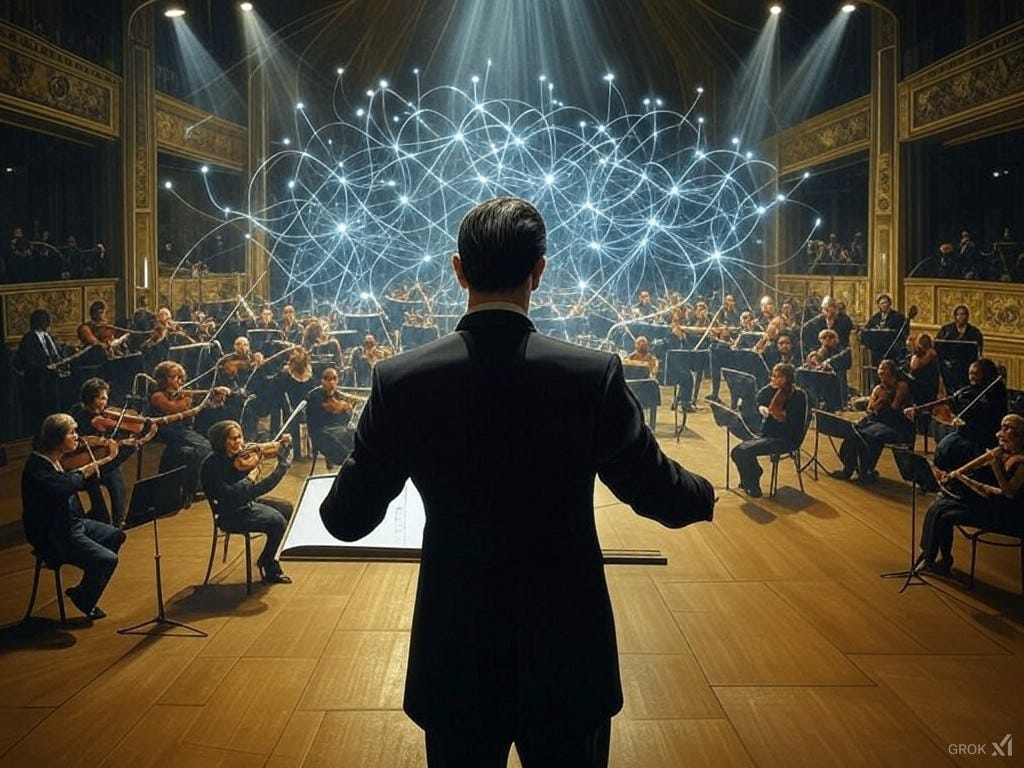The Symphony of AI: Understanding PyTorch and TensorFlow through the Lens of an Orchestra
Imagine a grand orchestra hall where each musician represents a neuron in a neural network, and the entire orchestra symbolizes a Large Language Model (LLM) like Grok. In this musical analogy, the conductor and the instruments they manage are crucial for creating harmony or, in our case, intelligent responses. This is where frameworks like PyTorch and TensorFlow come into play.
What are PyTorch and TensorFlow?
PyTorch and TensorFlow are like the conductors and instruments of our AI orchestra. They are programming frameworks designed specifically for building and training machine learning models:
PyTorch: Known for its ease of use, it's like a conductor who can adapt quickly, making adjustments on the fly. It uses a dynamic computational graph, meaning each note or section can change based on the performance, allowing for more experimental and fluid music-making.
TensorFlow: More like a conductor with a highly detailed score, it's historically been known for its static graph approach, where the music (or model computation) is planned out before the performance begins. This provides stability and efficiency but less flexibility in real-time.
Both frameworks handle the complexities of managing millions of neurons (musicians), ensuring they play in sync to produce coherent output, whether it's during the training phase (rehearsals) or inference (the actual concert).
Why are They Necessary?
Just as you can't have an orchestra without a conductor and instruments, you can't build or train a model like Grok without these frameworks:
Training (Rehearsals): These frameworks help in tuning each instrument (adjusting model parameters), teaching the orchestra new pieces (introducing new data), and correcting errors (backpropagation) to ensure the symphony (model) sounds perfect.
Inference (Performance): When the model is "performing" or generating responses, these frameworks ensure that the orchestra plays smoothly, interpreting the conductor's cues (user prompts) into beautiful music (accurate, helpful responses).
Why PyTorch for Modern AI Orchestration?
If we extend the orchestra analogy:
Dynamic Composition: PyTorch's dynamic graph is like having an orchestra where the conductor can change the score mid-performance based on audience reaction. This flexibility is invaluable in AI, where models like Grok need to adapt to new data or tasks quickly.
Ease of Learning: For new musicians joining the orchestra, PyTorch is more intuitive. Its Pythonic nature means less time learning how to play and more time perfecting the performance, mirroring how developers can quickly prototype and experiment with AI models.
Community and Innovation: Imagine if every orchestra shared their best arrangements (models) and techniques (research). PyTorch has become a hub for such sharing, fostering innovation. The community around PyTorch is vibrant, contributing to better "instruments" and "scores" for everyone.
Debugging and Experimentation: In an orchestra, if a section sounds off, you'd want to fix it immediately. PyTorch allows for this kind of real-time debugging, making it easier to tweak the model during training without having to start the rehearsal (training process) from scratch.
Performance and Deployment: While TensorFlow once had a lead in production environments, PyTorch has caught up, offering robust tools for deploying the symphony (model) in various settings, from mobile devices to the cloud, ensuring the music (AI responses) can reach any audience.
In summary, while both PyTorch and TensorFlow can conduct an AI orchestra like Grok, PyTorch's modern approach to composition, ease of learning, community support, and flexibility make it the preferred choice for today's AI music-making. It's like having a conductor who not only knows the score but can also improvise, adapt, and innovate, ensuring that the performance (AI model) is not just good but exceptional.



